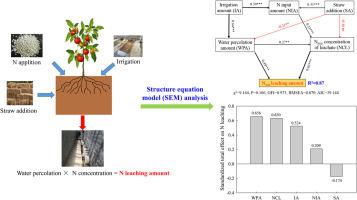Agriculture, Ecosystems & Environment ( IF 6.6 ) Pub Date : 2021-05-08 , DOI: 10.1016/j.agee.2021.107474 Haofeng Lv , Weiwei Zhou , Jing Dong , Shipeng He , Fei Chen , Minghao Bi , Qunyan Wang , Junliang Li , Bin Liang

|
Flood irrigation and over fertilization lead to a large amount of nitrogen (N) leaching in conventional plastic shed vegetable production systems, resulting in low N use efficiency and huge environmental costs. Drip fertilization can significantly reduce N leaching by reducing irrigation and N application; however, the respective roles of each factor in reducing N leaching remain unknown. In this study, structural equation modeling was carried out to determine the direct and indirect relationships among factors related to N leaching in plastic shed tomato production across six consecutive growing seasons. Treatments were as follows: conventional flooding irrigation and fertilization (CIF); CIF + corn straw (CIF + C); CIF + wheat straw (CIF + W); drip irrigation and fertilization (DIF); DIF + corn straw (DIF + C); and DIF + wheat straw (DIF + W). The results showed that the most important contributing factor to N leaching in this study was water percolation, which is mainly controlled by irrigation amount. This suggests that irrigation amount has a greater effect than N input rate and straw addition. Compared to CIF, DIF significantly reduced N leaching by an average of 63.9% without compromising tomato yield, with significant increases of 52.9% and 28.1% in the water use efficiency (WUE) and partial factor productivity of applied N (PFPN), respectively. Meanwhile, application of straw also resulted in a significant reduction in N leaching by reducing water percolation, with wheat straw having a greater effect than corn straw. Overall, excessive irrigation rather than N input was found to be the main cause of significant N leaching, highlighting the importance of optimal irrigation schemes. We therefore recommend precise drip irrigation and fertilization combined with straw addition for sustainable and environmentally-friendly plastic shed vegetable production.
中文翻译:

灌溉量在塑料棚蔬菜生产系统中占主导地位的土壤矿质氮淋失
洪水灌溉和过度施肥导致常规塑料棚蔬菜生产系统中大量的氮(N)浸出,导致氮利用效率低下和巨大的环境成本。滴灌施肥可以通过减少灌溉和施氮量来显着减少氮的淋失;然而,每个因素在减少氮淋失中的各自作用仍然未知。在这项研究中,进行了结构方程建模,以确定在连续六个生长季节中,塑料大棚番茄生产中与氮淋失相关的因素之间的直接和间接关系。处理方法如下:常规洪水灌溉和施肥;CIF +玉米秸秆(CIF + C); CIF +麦秸(CIF + W); 滴灌和施肥(DIF);DIF +玉米秸秆(DIF + C); 和DIF +麦秸(DIF + W)。结果表明,本研究中影响氮淋溶的最重要因素是渗水,渗水主要受灌溉量的控制。这表明灌溉量比氮输入速率和秸秆添加量具有更大的影响。与CIF相比,DIF显着减少了N浸出,平均降低了63.9%,而没有损害番茄的产量,水分利用效率(WUE)和部分施氮量(PFP)分别显着提高了52.9%和28.1%N)。同时,秸秆的施用还通过减少水的渗透而显着减少了氮的浸出,其中小麦秸秆的作用比玉米秸秆的作用大。总体而言,发现大量灌溉而非氮输入是造成大量氮淋失的主要原因,突显了最佳灌溉方案的重要性。因此,我们建议精确滴灌和施肥结合秸秆添加,以实现可持续和环保的塑料棚蔬菜生产。

























 京公网安备 11010802027423号
京公网安备 11010802027423号